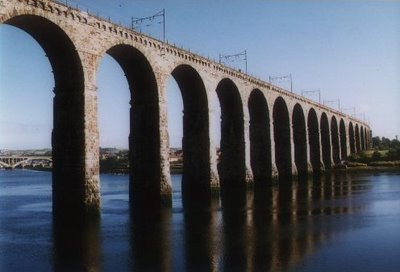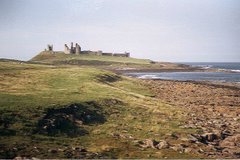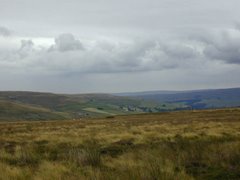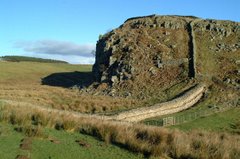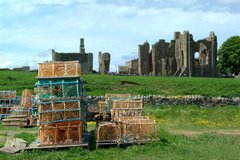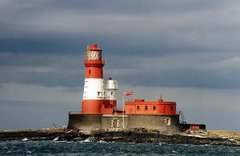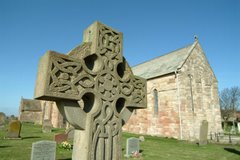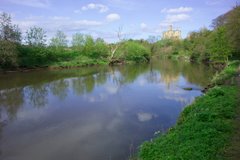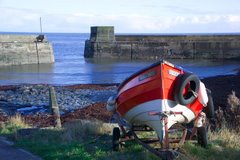Berwick upon Tweed
Berwick-upon-Tweed (commonly called just Berwick) is the most northerly town in the county of Northumberland and in England. The town has a population of about 12000 and is the administrative capital of Berwick Borough.
Berwick has changed hands several times throughout history. For a period of 300 and more years from the mid 11th century the town was an extremely important strategic asset in the wars between England and Scotland. The architecture of the town reflects its past, in particular in having one of the finest remaining defensive ramparts (of 1555, though much repaired in the late 18th century), and in the Barracks buildings, begun in 1717 and the first such buildings in Britain. Nikolaus Pevsner writes that Berwick is one of the most exciting towns in the country, with scarcely an irritating building anywhere, and the most intricate changes of level.
Today the Barracks is maintained by English Heritage and is the regimental home of the Kings Own Scottish Borderers. The town is also the lowest bridging point of the River Tweed, an important salmon fishery on the England-Scotland border.
The Old Bridge, a 15-span sandstone arch bridge measuring 1,164 feet in length, was built between 1610 and 1624. The bridge continues to serve road traffic, in one direction only. The current structure is a Grade I listed. Four previous bridges stood on the site, with two destroyed by flooding (in 1199, the original, and in 1294, the third), one by an English attack in 1216 and the last, built 1376, served until James I of England ordered the construction of the present bridge. It was then on the main road from Edinburgh to London, and the king (who was also James VI of Scotland) had had to cross over the then dilapadated wooden bridge in 1603 while travelling to London for his coronation.
The Royal Border Bridge, designed and built under the supervision of Robert Stephenson between 1847 at a cost of £253,000, is a 720-yard-long railway viaduct with 28 arches, carrying the East Coast Main Line 126 feet above the River Tweed. It was opened by Queen Victoria in 1850.
The Royal Tweed Bridge, built in 1925 and in its time having the longest concrete span in the country at 361 feet, was originally designed to carry the A1 road across the Tweed; the town now has a road bypass to the west. In the early 2000s, its fabric was renovated, the road and pavement layout amended, and new street lighting was added. Construction work was undertaken by L G Mouchel & Partners, who still operate today (as Mouchel Parkman). The design is of reinforced concrete and consists of four unequal arches.
The Union Bridge (five miles upstream), the world's oldest surviving suspension bridge. When it opened in 1820 it was the longest wrought iron suspension bridge in the world with a span of 137 metres (449 ft), and the first vehicular bridge of its type in Britain. Although work started on the Menai Suspension Bridge first, Union Bridge was completed earlier. Today it is the oldest suspension bridge still carrying road traffic.
Another quirky part of town's history is the Berwick Parish Church, unique for having been built during the Commonwealth of Oliver Cromwell. The building, constructed around 1650 using stone from the 13th century Castle (parts of which still stand by the railway station), began as a plain preaching box, with no steeple, stained glass or other decorations. Much altered with a conventional interior layout, contents include a pulpit thought to have been built for John Knox during his stay the town.
It is unique for an English town in that its football team, Berwick Rangers, plays its matches in the Scottish Football League; owing to the south-west to north-east direction of the border, it is located further north than several Scottish league clubs including Gretna, Queen of the South (Dumfries), Stranraer, Ayr United and Kilmarnock.
If you are interested in history, architecture and like the fresh sea breeze Berwick is an ideal place to visit.
Article adapted from the Wikipedia online encyclopedia.
How to get to Berwick:
By road: Berwick is conveniently located just off the main A1 road. It is about 60 miles north of Newcastle upon Tyne and 90 miles south of Edinburgh.
By rail: The nearest station is Berwick upon Tweed. The station is on the main east coast railway line and is served frequently by trains from London and Newcastle upon Tyne in the south and Edinburgh in the north.
By bus: Arriva Northumbria services 501 and 505 (525 on Sundays and Bank Holidays) runs from Newcastle upon Tyne via Morpeth, Alnwick, the North-Northumberland coast up to Berwick. Travelsure service 23 links Kelso in the Scottish Borders and Berwick. Perrymans service 253 links Edinburgh and Berwick.
Map of area: CLICK HERE
